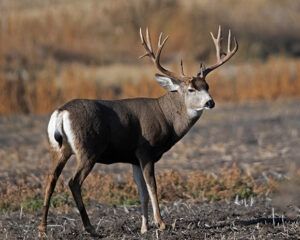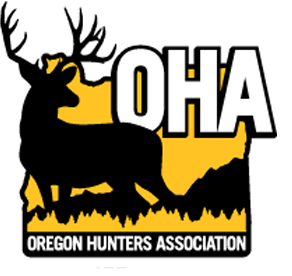For eastside deer and westside elk, the outlook is less than outstanding.
 By Jim Yuskavitch • Photo by Willy Onarheim
By Jim Yuskavitch • Photo by Willy Onarheim
How hard the winter was, and how dry the High Desert was the previous summer and the resulting impacts, such as overwintering mortality of big game species, may affect your hunt for the upcoming season. But the most important key to reliable, quality, successful hunting opportunities now and in the future lies in abundant, healthy big game populations that can weather those ups and downs and still come out of the gate strong.
If you hunt deer on Oregon’s east side or elk on the west side, the long-term trends are disturbing.
A multitude of factors affect the long-term fortunes of deer, elk and other Oregon big game species. Some, like available food sources, predation and disease, are typical factors wildlife managers have been dealing with for years. Others are trickier to address, such as expanding human populations and our increasing demands on natural resources. One example is more traffic on rural highways resulting in more deer/elk motor vehicle collisions. Once a minor issue, it is now putting a real dent in big game numbers in some areas. And when solutions can be found – such as wildlife crossings – they can be very expensive and take years to implement.
What follows is a brief look at the current status of Oregon’s big game populations and some things going on behind-the-scenes, especially for mule deer, to help rebuild those numbers where needed and keep them there.
Deer
Mule deer numbers in Oregon – and throughout the West – are still declining. Oregon’s mule deer numbers dropped by 3.6 percent over last year, with a total current estimated statewide population of 150,000 to 160,000 animals. Recent mule deer surveys show that of the 49 wildlife management units with identified mule deer herds, 27 had stable numbers while the remainder experienced declines. Only four units are at management objective, and below it in the rest. The Oregon mule deer population peaked in 1981 at an estimated 306,000, but has been in steady decline since then.
To address this ongoing decline and identify management actions, the ODFW is updating its Mule Deer Management Plan this year – the first revision since 2003. The initial mule deer plan was adopted in 1990.
OHA’s conservation staff and advisory council have worked closely with ODFW in the development of the revised mule deer plan, and many of OHA’s comments have been incorporated into the plan. (See related article on Page 46.)
The primary driver of mule deer populations is habitat and nutrition. When deer have proper habitat and abundant and nutritious food sources, they do well, and not so well when those resources are poor. However, there are other factors, including impacts of weather, predation, competition for food and space with elk and livestock, fragmentation of habitat and disruption of migration, vehicle collisions, hunter harvest, poaching and disease as part of the mix.
One of the key areas that ODFW is focusing on is seasonal movements and migration of various mule deer populations within and across wildlife management units. ODFW has typically managed mule deer populations based on unit boundaries. A flaw in that approach is that deer don’t pay attention to boundaries drawn by humans. For example, wildlife management unit boundaries are often drawn around easily identifiable landmarks, such as roads, to help hunters avoid inadvertently straying into a unit for which they don’t have a tag. But that’s not a concern for deer, and over the course of the year, herds move and migrate across the landscape, management unit boundaries, and into different management situations and varying habitat types and quality.
To factor those movements into management decisions, ODFW conducted a number of mule deer migration studies over the past several years throughout their Oregon range, identifying specific herds and their movements over the seasons. As a result of that research, ODFW has been able to identify home ranges of various herds across eastern Oregon as well as their summer and winter migratory movements. An important outcome from those studies is that ODFW has identified the biological boundaries of mule deer herds, which will significantly help management efforts, including harvest management.
Nevertheless, Oregon’s mule deer population has been in steady decline that so far no one has figured out how to reverse. Since its high point in 1981, the mule deer population has declined by nearly 50 percent. And that decline continues. With less opportunity for success, the number of mule deer hunters has dropped, as well, from 150,000 in 1986 to less than 50,000 by 2022, along with the loss in license and tag revenue needed to fund wildlife management and conservation. For the foreseeable future, hunters can expect conservative management, and decreases in the number of tags available each season more often than increases.
Mule deer buck harvest for the any-legal-weapon hunts was down in most regions last year from 2022, with the lone bright spot being the Northeast Region, where success increased from 33 percent to 36 percent and the harvest increased correspondingly from 4,770 to 5,339.
Bowhunting mule deer effort and harvest was up across the board.
The news for black-tailed deer is better. Not too many years ago, their numbers were believed to be low, with problems that included outbreaks of hair loss disease in some lower elevation Coast Range areas. Now, improved population models and better data indicate that black-tailed deer are no longer in decline and are likely even increasing in some management units.
Blacktail rifle success was up substantially in both the Northwest and Southwest regions, possibly owing to the latest-ending season in recent memory. Last year’s western Oregon bow success was down from the previous year.
Elk
Rocky Mountain elk in the northeastern part of the state continue to thrive, with 76 percent of wildlife management units at or near management objective. With an estimated population of 71,150, they are at 97 percent of MO across the board.
In western Oregon, Roosevelt elk numbers continue to be depressed, with an overall population of an estimated 54,830 animals. This is 77 percent of the objective of 70,850, although historically, that is well above the 1980 population of a little under 40,000. The most recent population high was about 65,000 in 2002. Overall numbers have been steadily dropping since then.
Statewide, elk hunter participation in rifle seasons was down 2.5 percent last year, and the average success rate for all hunts – including bull and antlerless harvest – also dipped from 19 percent in 2022 to 17 percent.
While predation plays a role, the probable primary culprit is the decline of logging on Forest Service lands in western Oregon, leading to less early seral stage habitat, which provides forage vegetation that helps grow elk (and deer) numbers. This situation is more prevalent in the Cascade Mountains, which is mostly composed of Forest Service lands. Further west in the Coast Range, large tracts of private commercial timberlands are still seeing regular logging operations along with improved ungulate habitat.
“While all the talk has been about Rocky Mountain elk, western Oregon elk numbers and harvest have declined, likely due to a combination of reduced logging and increased calf mortality from an expanding cougar population,” said Duane Dungannon, OHA State Coordinator. “OHA will be addressing western Oregon elk with ODFW. We are supporting some great habitat projects from the southwest Cascades to the Blue Mountain Elk Initiative, but there’s so much more that can be done, and we need every district on board.”
Complicating matters are necessary efforts to reduce conflicts on private lands through controlled antlerless hunts – even in units below management objectives. For example, the Willamette, Applegate and Melrose units that contain substantial parcels of private lands are elk de-emphasis areas.
Despite struggling Roosevelt elk herds, at approximately 126,000 animals, Oregon continues to have the third highest elk population in the United States, after Colorado and Montana.
Pronghorn
At 16,000 to 19,000 animals, pronghorn populations are stable. Because they are very sensitive to environmental conditions, drought or heavy winter snow can have a significant impact on pronghorn herds. Heavy winter snows that lasted well into spring 2023 caused some concern, but apparently pronghorns were not heavily impacted. This winter saw above average snowpack in southeast Oregon, but those heavy snows usually fall at higher elevations outside pronghorn winter range, so impacts are minimal. Snow at lower elevation provides moisture for spring green-up that benefits the animals.
Last year’s pronghorn harvest and success rates were both down about 10 percent from the previous year.
Bighorn Sheep
Occupying the northeast part of the state, the Rocky Mountain bighorn population is estimated at 800 to 900. Some herds continue to have respiratory disease issues, spread by contact with domestic sheep. ODFW is aggressively researching sheep diseases and tracking their spread by regularly testing Rocky Mountain bighorn herds with suspected health problems. It has also partnered with the Hells Canyon Restoration Initiative to work with ranchers to reduce the incidence of wild-domestic sheep encounters.
California bighorn sheep in southeast Oregon number 4,200 to 4,500, and although a few herds have experienced respiratory health problems, the overall population is generally stable. ODFW is continuing to test California bighorn sheep for the presence of respiratory disease.
In addition, ODFW has also been addressing reduced genetic diversity in the Trout Creek Mountains and Abert Rim California bighorn sheep herds by translocating 21 bighorn sheep from the I-84 Herd this past winter.
Rocky Mountain Goat
The total population of Rocky Mountain goats in Oregon is about 1,200 animals and are stable or increasing. The largest herds are in the Elkhorn and Wallowa mountains, while smaller populations are found in the Strawberry Wilderness and Mt. Jefferson areas. A large fire in 2020 caused the Mt. Jefferson goat population to redistribute itself, but their overall numbers were not affected.
Bear and Cougar
Oregon’s black bear population is close to 30,000 animals. To maintain a healthy population, ODFW monitors the yearly bear harvest through mandatory check-in to make sure they are not being over-harvested. Studies have shown that if the median age of all bears harvested is 3 years old or younger, the median age of males is 2 years old or younger and females 4 years old or younger, then the population is being over-harvested. Data collected in 2022 showed that median ages of harvested bears was 4 years for males, 5 years for females and 4 years overall, making the harvest well within conservation guidelines. More than half the bears taken in both spring and fall hunts were males.
The cougar population continues to slowly increase, with a current population estimate of 7,068. Cougars have been expanding in northwestern Oregon in recent years and are expected to continue occupying available territory and increasing their numbers until the population reaches carrying capacity, although it is difficult to say how long that will take.
